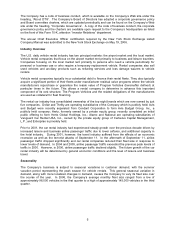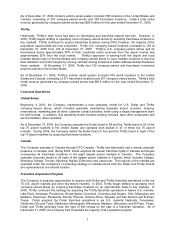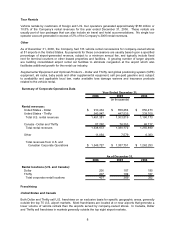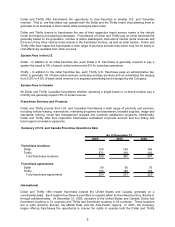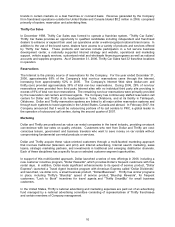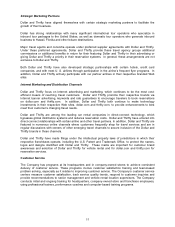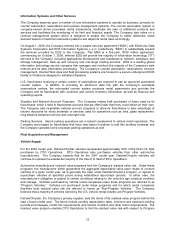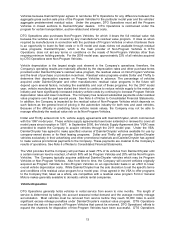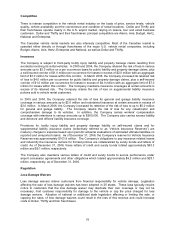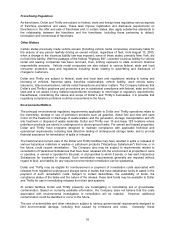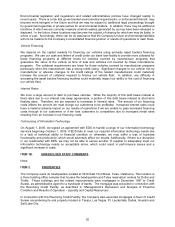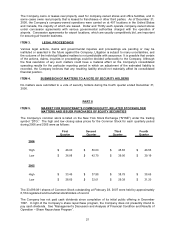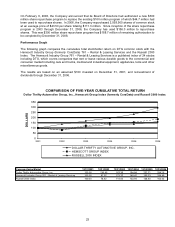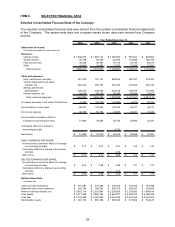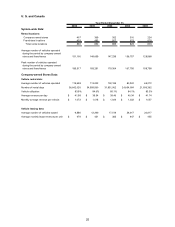Thrifty Car Rental 2006 Annual Report Download - page 21
Download and view the complete annual report
Please find page 21 of the 2006 Thrifty Car Rental annual report below. You can navigate through the pages in the report by either clicking on the pages listed below, or by using the keyword search tool below to find specific information within the annual report.Competition
There is intense competition in the vehicle rental industry on the basis of price, service levels, vehicle
quality, vehicle availability and the convenience and condition of rental locations. Dollar and Thrifty and
their franchisees operate mainly in the U.S. airport market, relying on leisure, tour and small business
customers. Dollar and Thrifty and their franchisees’ principal competitors are Alamo, Avis, Budget, Hertz,
National and Enterprise.
The Canadian vehicle rental markets are also intensely competitive. Most of the Canadian market is
operated either directly or through franchisees of the major U.S. vehicle rental companies, including
Budget, Alamo, Avis, Hertz, Enterprise and National, as well as Dollar and Thrifty.
Insurance
The Company is subject to third-party bodily injury liability and property damage claims resulting from
accidents involving its rental vehicles. In 2005 and 2004, the Company retained the risk of loss in various
amounts up to $2.0 million on a per occurrence basis for public liability and property damage claims, plus
a self-insured corridor of $1.0 million per occurrence for losses in excess of $2.0 million with an aggregate
limit of $3.0 million for losses within this corridor. In March 2006, the Company increased its retained risk
of loss to $4.0 million per occurrence for public liability and property damage claims, plus a self-insured
corridor of $1.0 million per occurrence for losses in excess of $4.0 million with an aggregate limit of $7.0
million for losses within this corridor. The Company maintains insurance coverages at certain amounts in
excess of its retained risk. The Company retains the risk of loss on supplemental liability insurance
policies sold to vehicle rental customers.
In 2005 and 2004, the Company retained the risk of loss for general and garage liability insurance
coverage in various amounts up to $2.0 million and maintained insurance at certain amounts in excess of
$2.0 million. In March 2006, the Company increased its retention of the risk of loss to up to $5.0 million
for general and garage liability. The Company retains the risk of loss for any catastrophic and
comprehensive damage to its vehicles. In addition, the Company carries workers' compensation
coverage with retentions in various amounts up to $500,000. The Company also carries excess liability
and directors' and officers' liability insurance coverage.
Provisions for bodily injury liability and property damage liability on self-insured claims and for
supplemental liability insurance claims (collectively referred to as “Vehicle Insurance Reserves”) are
made by charges to expense based upon periodic actuarial evaluations of estimated ultimate liabilities on
reported and unreported claims. As of December 31, 2006, the Company’s reserve for Vehicle Insurance
Reserves was approximately $103.9 million. The Company’s obligations to pay insurance related losses
and indemnify the insurance carriers for fronted policies are collateralized by surety bonds and letters of
credit. As of December 31, 2006, these letters of credit and surety bonds totaled approximately $63.3
million and $9.1 million, respectively.
The Company also maintains various letters of credit and surety bonds to secure performance under
airport concession agreements and other obligations which totaled approximately $9.2 million and $28.1
million, respectively, as of December 31, 2006.
Regulation
Loss Damage Waivers
Loss damage waivers relieve customers from financial responsibility for vehicle damage. Legislation
affecting the sale of loss damage waivers has been adopted in 25 states. These laws typically require
notice to customers that the loss damage waiver may duplicate their own coverage or may not be
necessary, limit customer responsibility for damage to the vehicle or cap the price charged for loss
damage waivers. Adoption of national or additional state legislation affecting or limiting the sale, or
capping the rates, of loss damage waivers could result in the loss of this revenue and could increase
costs to Dollar, Thrifty and their franchisees.
15


